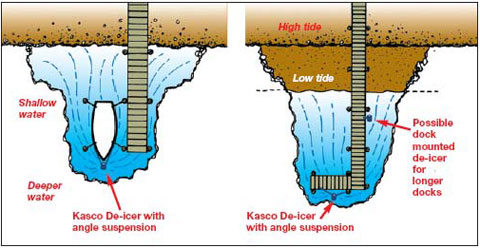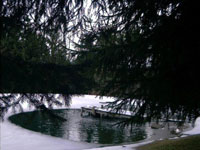
If you must leave your dock in for the Winter, preventing ice damage is your number one priority. This guide will explain the theory behind de-icers. By Van Isle Water.
De-Icing is more accurately referred to as an art form than an exact science. Each application and location is different and there is no set rule in determining how many De-Icers are needed for a given area or which mounting option is the best. The effectiveness of Kasco De-Icers largely depends on the depth of the surrounding water, obstructions in the water, and the geographic location of the installation.
Kasco De-Icers work by moving warm bottom water that is heated by the earth to the surface. The shallower the water in the area surrounding the De-Icer, the less warm water there is available. It is recommended that the De-Icer is 2.5′ to 5′ below the water surface. Obstructions in the water such as floats on docks, boat lifts, large dock pilings, boats, etc. may restrict the flow of water causing a smaller area of influence around the De-Icer.
Your geographic location will also play a major role in the effectiveness of your Kasco De-Icer at your lakefront home. The longer and colder the winter is, the more the water will cool over time and open water may be limited accordingly. Other factors that may effect open water areas are bottom contour, salt content, mounting, etc.
Below are some common ice damage problems outlined, as well as winter-kill conditions and summer water quality problems. Kasco De-Icers can help in each instance.
Utilizing your Kasco De-Icing Equipment

To de-ice a shallow water area, direct the flow of warmer water from the deeper area into the shallower area. Remember, a De-Icer works because it draws warmer, denser water from the bottom and circulates it upward to the surface, preventing ice formation or melting existing ice.
It is often easier to de-ice a boat by installing the de-icer at or near the bow, angled toward the stern. If the water flow is directed toward the shore or a retaining wall, it will flair, forming a desirable “T” shape de-icing pattern.
In tidal waters, split the difference in water depth so the De-Icer is in shallow water at low tide and deep water at high tide. Or, tie your De-Icer to the boat and allow the boat and De-Icer to rise and fall with the tide.
Ice Jacking/Lifting Damage

Jacking/Lifting damage can occur anytime ice and water levels fluctuate. The most common cause of lifting is the tide; however, lifting damage is common in the Great Lakes Region where weather and wind changes can cause smaller, but more rapid changes than tides. Jacking damage can also occur on any body of water regulated by man.
Repair costs are not only limited to physical damage, but also the down-time of dock facilities and time spent obtaining necessary government permits.
Maintaining and ice-free zone in and around dock structures is your very best protection against jacking/lifting damage. Keeping partially open water near dock structures will reduce ice thickness in the general area around docks and pilings and help to limit the risk of ice damage.
Ice Expansion Damage

Ice expansion pressure is a vastly underrated damage risk. The size of a body of water is directly proportional to expansion damage risk potential. The larger the body of water, the larger the potential damage risk will be. Pressure damage can affect that part of the dock structure nearest the shore or at the opposite end as shown above.
Although it may be preferred to maintain an ice-free zone around the dock structure, it is also possible to limit damage risk with an open water buffer zone. Kasco Horizontal Flotation units positioned between docks and expanding ice can relieve damaging expansion pressure.
Winter-Kill Conditions

Kasco De-Icers can be used to help prevent winter-kill conditions. During harsh winters with thick ice and heavy snow pack, your pond can experience a fish die off due to low oxygen levels. The heavy snow and ice prevent sunlight from penetrating into the water causing the existing aquatic vegetation to die off. As the vegetation dies, the decomposition process uses up much of the available oxygen in the pond. As the winter progresses, the oxygen levels continue to decrease and eventually, your fish may begin to die. Only 1% of the ponds total surface area needs to be ice free to prevent winter-kill situations. The cold water will become oxygenated by coming in contact with the air and prevent winter-kill on your pond.
Summer Water Quality Problems

Water quality during hot summer weather is an increasing problem for marinas and waterfront developments. Sheltered water, behind docks or under walkways where wind and current cannot reach, tends to become stagnant and dirty. As a result, algae and odor problems often develop, destroying an otherwise pleasant outdoor experience.
The use of Kasco De-Icers during hot summer weather to create a man-made current helps “Mother Nature” with her natural cleaning action. The quiet-running Kasco Horizontal Flotation unit produces an aesthetically pleasing high-volume water current in marinas, waterfront developments, and park facilities for improved water quality.
Re-Posted by Scott Freerksen “The Lake Guy”
